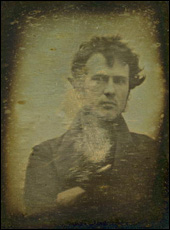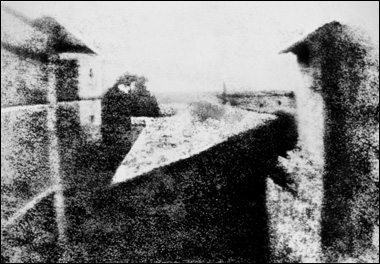It’s hard for me to imagine what life must have been like before the camera was invented.
We’re all so used to being flooded with images every day that we don’t realize how comparatively scarce pictures were before the 20th century. Artists were unique in society for their ability to create images and essentially had a monopoly on art.
That monopoly ended abruptly in 1826 with the creation of the world’s first photograph by Joseph Niépce.
As you can see, it looks nothing like photographs today. It was taken from a second story window yet you can barely make out the rooftops of the adjacent buildings. Niépce’s photo is much more of a science experiment than an art form, and of course he didn’t take the picture by just pushing a button. Exposure time took more than 8 hours while the picture slowly formed on a pewter plate. Despite its crudeness, Niépce’s success led to a revolution in art.
Frenchman Louis-Jacques-Mandé Daguerre created the first true camera soon after, based on Neipce’s scientific discoveries. Big and clumsy, these awkward boxes required not only a good knowledge of chemistry, but also the willingness to lug around heavy metal plates (instead of film) and a veritable apothecary of chemicals, beakers, test tubes, and other necessary equipment.

This self-portrait of Robert Cornelius is similar to many pictures taken during the height of the daguerrotype’s popularity. More can be found here as part of the Library of Congress’s daguerrotype collection.
Throughout the 19th century, photography was a tricky undertaking even for professionals, but with the invention of film the world changed once again.
Film replaced bulky metal plates and allowed cameras to be much smaller and more manageable for anyone to operate. By 1888 Kodak had made its first film camera and in 1901 the American public could buy a Kodak Brownie. It was the very first uncomplicated point-and-shoot camera. Simple, affordable, and so easy to use that practically everyone had to have one.
Does that last part sound familiar?
I think in a lot of ways the digital camera revolution we are experiencing today is very similar to what was happening then.
We have digital cameras in our cell phones, digital cameras on our key chains, even disposable digital cameras. Every year they get easier and more convenient. The Sony Cybershot for example now has a 3″ LCD preview screen even though it’s only 3-¾” wide. That was unthinkable just a few years ago.
New advances in technology also help us take better pictures, or at least eliminate some of the easy errors that can crop up. Several FujiFilm cameras now are installed with face recognition software for perfect auto-focusing every time.
Making pictures has become so ridiculously simple that we have to wonder where it leaves us; artists whose livelihood depend on making images? Like the portrait painters of the early 1900’s, will our skills become unnecessary as technology makes us obsolete?
I doubt it.
After all, painting survived the rise of the camera, although many predicted it wouldn’t.
And no matter how incredible camera technology becomes, at least there will always be a need for artists to push that button. Or, I suppose, to delete a lot of bad photos.
This post may contain affiliate links.

